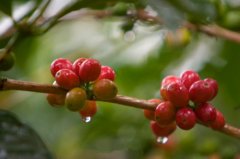Brazil Coffee processing Diversified Coffee basic knowledge
Brazilian coffee farms choose sun, half-sun or water washing treatments according to the dry and humidity conditions of the climate to show the best regional flavor. Such a pluralistic approach is rare in the world.
Before 1999 ⊙, rough tanning was almost always used in Brazil. This is the main culprit for Brazilian beans to catch the smell of sour and rotten wood, because coffee fruits get moldy and smell when the rain returns to moisture or the fruit is cracked during a two-to three-week exposure. This problem has been criticized for a long time, which has dealt a heavy blow to the image of Brazilian coffee. After 1999 ⊙, Brazilian research units developed a half-sun method to shorten the treatment time based on the drier climate in Brazil. After removing the pulp, the coffee fruit will be exposed to the pectin-coated pods for one to three days, and then machine-dried to a moisture content of 12%, which can be placed in a storage container. The Brazilian half-sun method greatly shortens the working time (the waste time of the traditional sun method is two to three weeks). It also reduces the chance of coffee beans getting a bad smell, and the quality is greatly improved. Moreover, the half-sun method also inherited the advantages of the sun method to improve the sweetness, but less thankless soil flavor, won the praise of international coffee experts. The winners of Brazil's "extraordinary cup" of national treasure beans almost all use the half-sun method, because this treatment can reduce the smell of soil and wood, and enhance the aroma and sweetness of Brazilian beans, which is most suitable for single products. as a result, half-sun drying has become the "wardrobe" of Brazilian boutique beans.
But this does not mean that the sun method has declined in Brazil, the ultra-low humidity of Minas central and western Serrado is still dominated by the sun method. The manor here believes that as long as the sun is strictly controlled, it can best highlight Serrado's unique nutty flavor and sweetness, while half-sun has become a supporting role in Serrado. The manor in South Minas is the most inclusive, using half-sun, sun and water washing respectively, showing the most yuan of flavor. In addition, Bahia province is famous for its washed beans, but almost all the winners in major cups are half-sun beans, and the coffee farms belonging to the diamond plateau, which are becoming popular, are famous for half-sun exposure.
The use of sun, half-sun or water washing methods depends on the local humidity conditions, as it can seriously affect whether the pods are overfermented and moldy during drying. Local estates will consider the best way to reduce the growth of mold to deal with coffee beans. In principle, the washing method should be used in the areas with high humidity, and the sun or half-sun should be used in the areas with low humidity.

Important Notice :
前街咖啡 FrontStreet Coffee has moved to new addredd:
FrontStreet Coffee Address: 315,Donghua East Road,GuangZhou
Tel:020 38364473
- Prev

Brazilian boutique beans main stem South Minas coffee beans
Brazil is flat, with coffee farms mostly about 600-1000 meters above sea level, suitable for growing shade-free Kaddura, New World and Kaduai, also known as Sm CofFee. This is the main reason for the lack of aroma of Brazilian coffee (but when the altitude is more than 1100 meters, the taste of exposed coffee will improve, comparable to bourbon. See Chapter 4 of this book). The good news is that
- Next

Brazilian Santos Coffee can't be seen yesterday. Brazilian Coffee
Brazil also has bulk commercial coffee Santos. More than 20 years ago, Bourbon Santos (Bourbonsantos) was the highest grade coffee in Brazil. It was neither sour nor bitter nor fragrant, light as water was the most important feature, but without personality beauty. In the past, as long as there was no bitterness, it was good coffee. However, after 1999 ○, the trumpet of boutique coffee was blown all over the world, and the fragrant Santos soon perished.
Related
- Detailed explanation of Jadeite planting Land in Panamanian Jadeite Manor introduction to the grading system of Jadeite competitive bidding, Red bid, Green bid and Rose Summer
- Story of Coffee planting in Brenka region of Costa Rica Stonehenge Manor anaerobic heavy honey treatment of flavor mouth
- What's on the barrel of Blue Mountain Coffee beans?
- Can American coffee also pull flowers? How to use hot American style to pull out a good-looking pattern?
- Can you make a cold extract with coffee beans? What is the right proportion for cold-extracted coffee formula?
- Indonesian PWN Gold Mandrine Coffee Origin Features Flavor How to Chong? Mandolin coffee is American.
- A brief introduction to the flavor characteristics of Brazilian yellow bourbon coffee beans
- What is the effect of different water quality on the flavor of cold-extracted coffee? What kind of water is best for brewing coffee?
- Why do you think of Rose Summer whenever you mention Panamanian coffee?
- Introduction to the characteristics of authentic blue mountain coffee bean producing areas? What is the CIB Coffee Authority in Jamaica?

